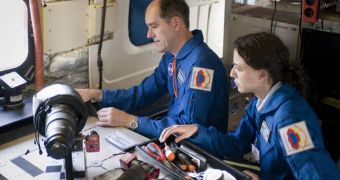The anticipated return of the Hayabusa space probe from its journey to a near-Earth object (NEO) has had the international astronomical community buzzing with excitement. Experts hope that the spacecraft's canisters contain samples of asteroid dust, or even small space rocks, collected directly from the NEO 25143 Itokawa. If the sample canister is safely recovered, then this mission could represent the first successful sample-return flight to a near-Earth object, Space reports. This approach to space exploration allows scientists to gain more insights into celestial mechanics, and also into how the solar system first appeared and developed.
Hayabusa is currently scheduled to land on June 13 (Sunday), at the Woomera Prohibited Area (WPA), in Southern Australia. This is the largest land-based ammunition testing facility in the world, as it covers an area about the size of England. Its surface is 127,000 square kilometers (49,000 square miles). The Japanese Aerospace Exploration Agency (JAXA) collaborates with the Australian government in this matter, having already obtained clearance to land its space probe there. But now, NASA too has become involved in surveying the spacecraft's return.
Just recently, a DC-8 airplane containing scientific equipment and a 30-member science crew lifted off from the United States, headed towards Australia. The team on the aircraft will be in charge with surveying the reentry stage of Hayabusa's mission. The probe departed Earth in 2003, and was supposed to return in 2007, but various glitches in its advanced propulsion system prolonged its flight by an additional 3 years.
“Hayabusa is hurtling toward Earth at an immense speed, comparable to that of an asteroid impact. The capsule that protects the asteroid sample will be only 6,500 feet ahead of the rest of the spacecraft, which will break into numerous pieces, essentially making it a man-made meteor,” explains scientist Peter Jenniskens. He is the principal investigator of the observations campaign, and holds joint appointments at the Moffett Field, California-based NASA Ames Research Center, and the Mountain View-based SETI Institute. He explains that the DC-8 airplane NASA operates will feature special windows, that will harbor a number of scientific instruments.
By flying at an altitude of about 39,000 feet, the team will be able to identify most of the fragments that Hayabusa will separate into, which will give researchers an additional view of how atmospheric reentry affects spacecrafts. “The return of Hayabusa provides NASA and JAXA with a rare opportunity to monitor the performance of an atmospheric entry vehicle at speeds much higher than that of the space shuttle returning from low-Earth orbit,” says Ames observation campaign project manager Jay Grinstead.
“The spectrum of light emitted by the gas and surface at these extreme temperatures tells us about the physics and chemistry of atmospheric entry. Our vantage point onboard the DC-8 and the variety of instruments enable us to track the evolution of the spectrum and compare it to simulations used for design and analysis of entry systems,” he concludes.

 14 DAY TRIAL //
14 DAY TRIAL //